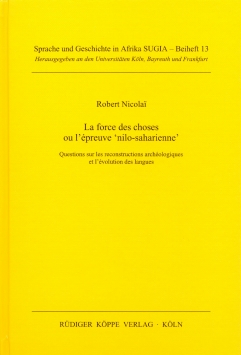
La force des choses ou l’épreuve ‘nilo-saharienne’
Questions sur les reconstructions archéologiques et l’évolution des langues
Author: Robert Nicolaï.
Series: Sprache und Geschichte in Afrika. SUGIA Supplements Volume 13
200316 pp. Roman, 577 pp.
2 maps, 2 facsimile illustrations, numerous tables and charts, appendices: Ethnolinguistic Situation in Bagudo Local Government, Récapitulatif des rapprochements analysés, Les semantic sets de Lionel Bender, Inventaire des entrées croisées avec les racines PNS de Christopher Ehret, index
Text language(s): French
Format: 160 x 240 mm
1190 g
Hardcover
€ 69.80
Buy 'La force des choses ou l’épreuve ‘nilo-saharienne’' as a downloadable PDF document directly from our online shop »
Order 'La force des choses ou l’épreuve ‘nilo-saharienne’' as print edition »
Nilo-Saharan is one of the four major language families on the African continent. It extends eastwards from the Niger to Western Ethiopia and further southwards to Northern Tanzania. Whereas the status of Nilo-Saharan as a phylum has been largely accepted since Greenberg (1963), the internal classification has remained controversial. Greenberg included Songhay in the Nilo-Saharan family, others regarded it as an isolated language or even belonging to the Chadic languages.
Proceeding on the background of the controversial discussion and on the basis of his own sources, the author of the present volume attempts a further in-depth analysis and a new historio-linguistic classification of Songhay. In the first place, he critically discusses the genetical proposals for classification of Bender (1997) and Ehret (2001) before analysing the lexical relation of Songhay with Afro-Asian languages which hitherto have not been paid much attention to. He thereby concludes that Songhay is not a member of the Nilo-Saharan language family, but instead stands in a certain non-genealogical relation with the Afro-Asian family that has to be determined more specifically. This assumes an old situation of contact between Songhay and the Afro-Asian languages.
This study stresses the manifold historio-linguistic factors. The conclusions the author arrived at have further implications:
1. in the empirical range: The global connection of the alleged Nilo-Saharan family and the methods of their construction are questioned. At the same time the necessity emerges to develop a new research field which applies on the dynamics of contact between the Afro-Asian languages and the adjacent Sub-Saharan languages.
2. in the theoretical and methodological range: It can be observed that the classical methods of historical comparison of scriptless languages are limited and that the uncritical application bears the danger of false reconstructions.
3. in the anthropological and ‘historical’ range: This study shows how new and more precise research approaches contribute to clarify the socio-cultural processes resulting from this contact zone in Africa.
In the course of his work the author analyses how dialectological, areal and stratificatorial aspects have an influence on the dynamics of historical language development. He stresses the risks of fixed reconstruction patterns a historio-comparative scientist has to deal with. For Nicolaï language contact and multilinguality are the main explanations for language development.
Under these links you will find publications by the author and descriptions of further Songhai/Songhay varieties of West Africa:
Accompanying material:
- A Grammar of Koyraboro (Koroboro) Senni
(ISBN 978-3-89645-106-4 ) - A Grammar of Tadaksahak
(ISBN 978-3-89645-931-2 ) - A Historical-Comparative Reconstruction of Nilo-Saharan
(ISBN 978-3-89645-098-2 ) - Lexique Dendi (Songhay)
(ISBN 978-3-927620-45-2 ) - Texts in Koroboro Senni (Songhay of Gao, Mali)
(ISBN 978-3-89645-261-0 ) - Texts in Koyra Chiini (Songhay of Timbuktu, Mali)
(ISBN 978-3-89645-260-3 )
Cross-reference:
- Advances in Nilo-Saharan Linguistics
(ISBN 978-3-89645-140-8 ) - Études berbères IV – Essais lexicologiques et lexicographiques et autres articles
(ISBN 978-3-89645-925-1 ) - Language Contact, Language Change and History Based on Language Sources in Africa
(ISBN 978-3-89645-093-7 ) - Studia Chadica et Hamitosemitica
(ISBN 978-3-927620-87-2 )
Reviews
In spite if its title, this is a book on Songhay. Its author, professor at Nice university, is among the world’s greatest specialists of this language family, and has written an impressive series of articles and books – impressive both in quantity and quality – on questions of Songhay linguistics, Songhay linguistic history, and the theory and methods of linguistic comparison.
The present book is a sophisticated sequel to Nicolaï (1990), where he explained, among others, his view of the linguistic origin of Songhay.
Maarten Kossmann in Journal of African Languages and Linguistics, 26/1, 2005, 99-102
| « back | Print version | [top] |
 Books
Books Audio
Audio Biographies
Biographies Series
Series Festschrifts
Festschrifts Journals
Journals